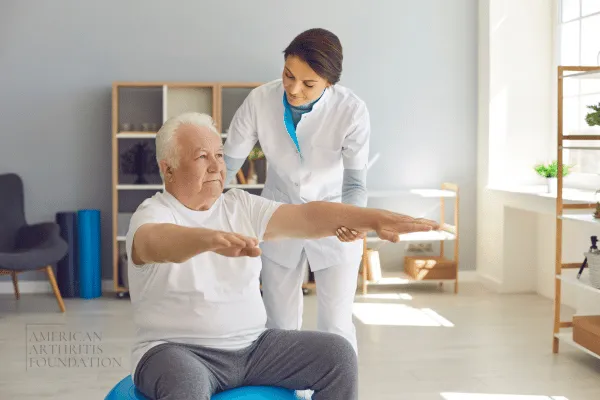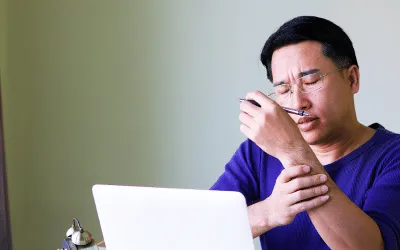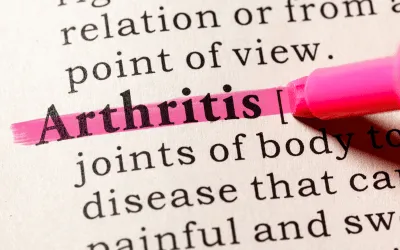About Arthritis
As the nation’s #1 cause of disability, arthritis affects nearly 60 million adults and 300,000 children. Over 100 types of arthritis and related conditions damage the joints and often other organs.
How can we assist you?
Helpful Tools for You

Your Guide to Exercise and Physical Therapy in 2025: What's New and What Works
The Exercise and Physical Therapy Revolution
If you've been following health news lately, you've likely noticed exciting developments in exercise and physical therapy. The year 2025 has brought remarkable innovations that are making it easier, more effective, and more convenient for people to stay active and recover from injuries—especially for older adults.
Whether you're looking to prevent falls, manage chronic conditions, or recover from surgery, the landscape of exercise and physical therapy has evolved dramatically. Today's approaches combine time-tested methods with cutting-edge technology to deliver personalized care that fits your lifestyle and needs.
Let's explore what's new, what's proven to work, and how you can take advantage of these developments to improve your health and quality of life.
Why Exercise and Physical Therapy Matter More Than Ever
Recent studies confirm what healthcare providers have long known: regular physical activity and properly administered physical therapy are among the most powerful tools we have for healthy aging. Exercise programs for older adults have maintained their position as the #3 fitness trend for 2025, reflecting the growing recognition of their importance.
The statistics are compelling:
60% of individuals aged 55 and older have sought professional physical therapy services
86% of patients who have undergone physical therapy reported finding it helpful
Studies show physical therapy can reduce the need for opioid medications by 87%
What's particularly encouraging is that the physical therapy profession is expected to grow by 14% from 2023 to 2033, creating more opportunities for people to access these valuable services.
What's New in 2025: Technology Meets Traditional Care
Virtual Physical Therapy: Care That Comes to You
One of the most significant developments is the expansion of telehealth physical therapy services. Physical therapists, occupational therapists, and speech-language pathologists can continue delivering virtual care to Medicare beneficiaries through September 2025, making these services more accessible than ever.
How Virtual PT Works:
Real-time consultations: Meet with your therapist via video call from the comfort of your home
Exercise guidance: Receive personalized instruction and immediate feedback on your form
Progress monitoring: Track your improvement using simple tools and apps
Flexible scheduling: Fit therapy sessions around your daily routine
Who Benefits Most:
People with mobility challenges who find it difficult to travel to clinics
Those living in rural or underserved areas
Individuals with busy schedules or transportation limitations
Patients who need frequent check-ins but not hands-on treatment
Wearable Technology: Your Personal Health Assistant
Wearable technology continues as the #1 fitness trend in 2025, and for good reason. These devices have evolved far beyond simple step counters to become sophisticated health monitoring tools.
Modern Wearables Can Track:
Heart rate and heart rate variability
Sleep patterns and quality
Physical activity levels and exercise compliance
Balance and gait patterns
Stress levels and recovery metrics
Practical Applications:
Exercise motivation: Set realistic daily goals and receive encouragement
Safety monitoring: Some devices can detect falls and alert emergency contacts
Medical insights: Share data with your healthcare providers for better treatment planning
Progress tracking: See concrete evidence of your improvement over time
Artificial Intelligence: Personalized Exercise Programs
AI and machine learning technologies are expanding rehabilitation care capabilities to remote locations, allowing for more personalized and effective treatment plans.
AI-Enhanced Features:
Customized exercise programs: Algorithms create workouts tailored to your specific needs and limitations
Real-time adjustments: Programs adapt based on your performance and progress
Risk assessment: Early identification of potential problems before they become serious
Outcome prediction: Better estimates of recovery timelines and expected results
Evidence-Based Exercise Recommendations for Older Adults
The Foundation: Balance, Strength, and Flexibility
The American College of Sports Medicine recommends balance activities at least two times per week for older adults, with some guidelines suggesting balance training at least three days per week.
Essential Balance Exercises:
Single-leg stands: Hold onto a chair for support, lift one foot slightly off the ground
Heel-to-toe walking: Walk in a straight line, placing one foot directly in front of the other
Sit-to-stand: Practice rising from a chair without using your arms
Weight shifting: While standing, shift your weight from one foot to the other
Strength Training: Building and Maintaining Muscle
Research shows that balance training produced the greatest increase in lower body strength (40%) compared to other exercise types, but traditional strength training remains crucial for overall health.
Safe Strength Training Principles:
Start light: Begin with bodyweight exercises or light resistance bands
Focus on form: Proper technique is more important than heavy weights
Progressive overload: Gradually increase difficulty as you get stronger
Rest and recovery: Allow muscles to repair between sessions
Recommended Exercises:
Wall push-ups: A gentler alternative to floor push-ups
Chair squats: Sit and stand from a chair to build leg strength
Resistance band exercises: Safe, adjustable resistance for all fitness levels
Carrying exercises: Practice carrying groceries or other daily items
Flexibility and Range of Motion
Maintaining flexibility becomes increasingly important as we age. Programs that combined yoga, tai chi, and resistance training showed improvements in strength, balance, and gait endurance.
Effective Flexibility Approaches:
Daily stretching: 10-15 minutes of gentle stretching each morning
Yoga: Modified poses that improve flexibility and balance
Tai chi: Slow, flowing movements that combine flexibility with balance training
Water exercises: Pool-based activities that allow movement with reduced joint stress
Specialized Physical Therapy Approaches
Aquatic Therapy: Exercise Without Impact
Aquatic therapy remains one of the most popular physical therapy trends because it helps people who have difficulty exercising against gravity.
Benefits of Water-Based Exercise:
Reduced joint stress: Buoyancy supports your body weight
Natural resistance: Water provides gentle resistance for muscle strengthening
Improved circulation: Water pressure helps reduce swelling
Enhanced relaxation: Warm water can help reduce muscle tension and pain
Common Aquatic Therapy Activities:
Water walking: Forward, backward, and sideways movements
Gentle water jogging: Low-impact cardiovascular exercise
Range of motion exercises: Stretching and flexibility work
Balance training: Using water's resistance to improve stability
Telehealth Physical Therapy: The New Standard
Telehealth platforms now enable therapists to conduct thorough evaluations remotely, with advanced tools providing real-time data on patient movements.
What to Expect from Virtual PT:
Initial assessment: Detailed evaluation of your movement patterns and limitations
Exercise instruction: Clear demonstration of proper technique
Progress monitoring: Regular check-ins to adjust your program
Educational support: Information about your condition and recovery process
Preparing for Your Virtual Session:
Space: Clear area with good lighting and stable internet connection
Equipment: Comfortable clothes and any recommended exercise tools
Questions: Prepare a list of concerns or questions about your condition
Specialized Programs for Common Conditions
Arthritis Management
Gentle range of motion exercises: Maintain joint flexibility
Strengthening exercises: Support joints with stronger surrounding muscles
Pain management techniques: Heat/cold therapy and gentle movement
Activity modification: Learning safer ways to perform daily tasks
Fall Prevention
Balance training: Specific exercises to improve stability
Strength building: Focus on legs, core, and postural muscles
Home safety assessment: Identifying and addressing fall risks
Confidence building: Gradual progression to reduce fear of falling
Post-Surgical Recovery
Graduated exercise programs: Carefully progressive movement plans
Pain management: Non-medication approaches to managing discomfort
Functional training: Returning to normal daily activities
Long-term maintenance: Preventing future problems
Creating Your Personal Exercise and Therapy Plan
Getting Started: The First Steps
Week 1-2: Assessment and Foundation
Consult your healthcare provider: Discuss your goals and any limitations
Consider a physical therapy evaluation: Get a professional assessment of your needs
Start with basics: Begin with simple balance and flexibility exercises
Track your baseline: Note your current abilities and comfort level
Week 3-4: Building Your Routine
Add strength training: Incorporate 2-3 sessions per week
Increase balance work: Practice balance exercises daily
Consider technology: Explore wearable devices or exercise apps
Find activities you enjoy: Choose exercises that feel sustainable
Working with Healthcare Professionals
Choosing a Physical Therapist:
Credentials: Look for licensed physical therapists with experience in your condition
Communication style: Find someone who explains things clearly and listens to your concerns
Treatment approach: Seek providers who use evidence-based methods
Accessibility: Consider location, scheduling, and telehealth options
Maximizing Your Therapy Experience:
Be honest: Share all symptoms, concerns, and limitations
Ask questions: Understand why specific exercises are recommended
Practice at home: Follow through with prescribed exercises between sessions
Communicate progress: Report both improvements and ongoing challenges
Using Technology Effectively
Wearable Devices:
Start simple: Begin with basic step counting and heart rate monitoring
Share data: Discuss your findings with healthcare providers
Set realistic goals: Use technology to motivate, not overwhelm
Focus on trends: Look for patterns rather than daily fluctuations
Exercise Apps and Online Resources:
Choose reputable sources: Look for programs developed by qualified professionals
Match your fitness level: Select programs appropriate for your abilities
Complement, don't replace: Use technology to enhance, not substitute for, professional care
Stay safe: Stop any exercise that causes pain or discomfort
Common Concerns and How to Address Them
"I'm Too Old to Start Exercising"
The Reality: Today's fitness programs should reflect the diversity of older adults' fitness levels, offering options for every level of ability to increase longevity and healthy years of life.
Starting Points for Any Age:
Chair exercises: Strength and flexibility work from a seated position
Gentle walking: Even 5-10 minutes daily provides benefits
Breathing exercises: Simple techniques that improve circulation and reduce stress
Gradual progression: Build slowly and consistently
"I Have Multiple Health Conditions"
The Approach: Modern physical therapy takes a comprehensive approach, addressing multiple conditions simultaneously while ensuring safety.
Key Principles:
Medical clearance: Always consult with your healthcare provider first
Individualized programs: Treatment plans tailored to your specific combination of conditions
Monitored progression: Careful advancement based on your response
Team approach: Coordination between different healthcare providers
"I Can't Afford Physical Therapy"
Available Options:
Insurance coverage: Medicare now covers telehealth physical therapy services
Community programs: Many locations offer low-cost or free exercise programs for seniors
Home exercise programs: Self-guided routines based on professional recommendations
Group classes: Shared-cost options that provide professional guidance
The Future of Exercise and Physical Therapy
Emerging Trends to Watch
Preventive Care Focus: Physical therapists are increasingly working with individuals to provide injury prevention programs, including exercises to strengthen specific muscle groups and improve posture.
Integrated Healthcare: Collaborative approaches involving multidisciplinary healthcare teams are becoming more prevalent to address holistic patient care.
Advanced Technology Integration: By 2025, neurocognitive assessments and training embedded in physical therapy programs will likely become the new standard.
Preparing for What's Next
Stay Informed:
Regular check-ups: Keep up with routine healthcare visits
Continuing education: Stay informed about new developments in exercise and therapy
Technology comfort: Gradually become more comfortable with helpful technologies
Community involvement: Participate in local health and wellness programs
Build a Support Network:
Healthcare team: Maintain relationships with your medical providers
Exercise partners: Find friends or family members to stay active with
Professional resources: Know how to access physical therapy and exercise guidance
Community connections: Join groups or programs that support healthy aging
Your Action Plan: Taking the First Step
This Week
Schedule a check-up: Discuss your exercise goals with your healthcare provider
Try a simple balance exercise: Practice standing on one foot for 10 seconds
Research local resources: Look into community exercise programs or physical therapy clinics
Start tracking: Begin noting your daily activity levels and how you feel
This Month
Begin a regular routine: Establish a sustainable exercise schedule
Consider professional guidance: Evaluate whether physical therapy would be beneficial
Explore technology options: Research wearable devices or exercise apps that might help
Connect with others: Find exercise partners or join a group program
Long-term Goals
Maintain consistency: Build exercise into your daily routine
Monitor progress: Track improvements in strength, balance, and overall well-being
Adapt as needed: Adjust your program as your abilities and interests change
Share your experience: Help others by sharing what you've learned
The world of exercise and physical therapy has never been more accessible or more personalized. Whether you're managing a chronic condition, recovering from surgery, or simply wanting to stay active and independent, today's options provide unprecedented opportunities for success.
Remember that every person's journey is unique. What matters most is finding approaches that work for your lifestyle, abilities, and goals. The combination of proven traditional methods and innovative new technologies means there's never been a better time to take charge of your physical health.
Your health is an investment, not an expense. The time and effort you put into exercise and physical therapy today will pay dividends in increased independence, better quality of life, and greater confidence in your daily activities.
Start where you are, use what you have, and do what you can. Your future self will thank you for taking that first step today.
Remember to always consult with your healthcare provider before beginning any new exercise program or making changes to your current routine. This article is for informational purposes and should not replace professional medical advice.

Effects of Arthritis

Cause of Disability
In the United States, 23% of all adults, or more than 54 million people, have arthritis. It is a leading cause of work disability, with annual costs for medical care and lost earnings of $303.5 billion.

Workforce Effects
Sixty percent of US adults with arthritis are of working age (18 to 64 years). Arthritis can limit the type of work they are able to do or keep them from working at all.

Global Impact
In fact, 8 million working-age adults report that their ability to work is limited because of their arthritis. For example, they may have a hard time climbing stairs or walking from a parking deck to their workplace.
Promoting Interventions That Reduce Arthritis Pain
American Arthritis Foundation recognizes several proven approaches to reduce arthritis symptoms:
Be active. Physical activity—such as walking, bicycling, and swimming—decreases arthritis pain and improves function, mood, and quality of life. Adults with arthritis should move more and sit less throughout the day. Getting at least 150 minutes of moderate-intensity physical activity each week is recommended.
Protect your joints. People can help prevent osteoarthritis by avoiding activities that are more likely to cause joint injuries.
Talk with a doctor. Recommendations from health care providers can motivate people to be physically active and join a self-management education program. Should your arthritis be interfering with your activities of daily living you may be a candidate to receive many new treatments, and learn how to reverse the arthritis condition.
Have a question?
We're Here to Help
By providing my phone number, I agree to receive text messages from the business.


